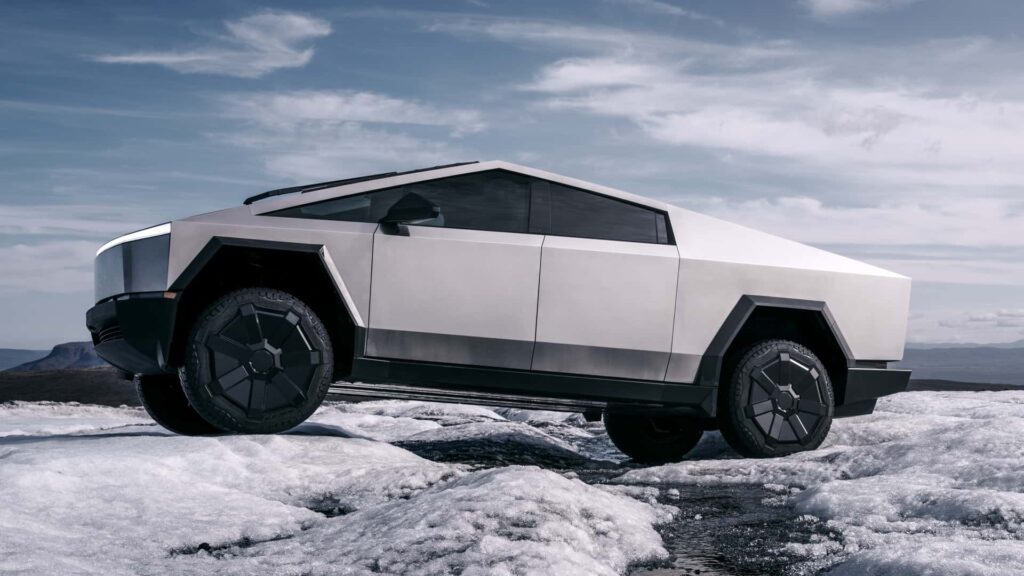The Tesla Cybertruck has introduced a groundbreaking new feature in the form of a 48-volt low-voltage system, replacing the traditional 12-volt system that has been prevalent in vehicles for years. This shift was confirmed by Tesla during the 2023 Investor Day in March and has now been implemented in the final product.
The decision to upgrade to a 48-volt system for auxiliary onboard devices is a significant one, as it offers several advantages over the older 12-volt system. By increasing the voltage, the same power can be supplied at a lower current, reducing losses and allowing for the use of thinner wires, thereby saving weight and cost. While larger vehicles have already been using 24-volt systems, the adoption of a 48-volt system in cars is still relatively uncommon.
Tesla is not content with merely incorporating this innovation into its own vehicles; the company is actively seeking to promote the 48-volt architecture throughout the industry. To this end, Tesla has shared the 48-volt system specifications with other manufacturers, including Ford. Ford CEO Jim Farley has acknowledged receipt of the specifications and expressed enthusiasm for the potential impact on the industry. It is likely that Ford will follow Tesla’s lead and integrate a 48-volt system into its future all-electric vehicles.
Despite the evident benefits of upgrading to a 48-volt system, the automotive industry may face challenges in making the transition. Redesigning vehicle wiring and replacing electric components to accommodate the higher voltage will require significant investment and potentially disrupt existing supply chains. However, with Tesla leading the way, other manufacturers may be more inclined to develop their own 48-volt systems to remain competitive in the evolving market.
In a conversation with Elon Musk, Sandy Munro of Munro Live discussed the 48-volt system in the Tesla Cybertruck and the obstacles that have hindered such advancements in the past. The insights gained from this dialogue may shed light on the future of low-voltage systems in the automotive industry.
While Tesla has already made strides in improving low-voltage systems with the transition to 12-volt lithium-ion auxiliary batteries in their electric vehicles, the introduction of a 48-volt system in the Tesla Cybertruck represents a new frontier. Although specific details about the Cybertruck’s 48-volt auxiliary battery have not been released, it is likely that Tesla has once again opted for the superior performance of lithium-ion technology. As the automotive industry continues to evolve, innovations like the 48-volt system in the Tesla Cybertruck are paving the way for a more efficient and sustainable future. When it comes to the Tesla Cybertruck, one of the key questions that enthusiasts and potential buyers have is what type of battery cells are used in this innovative electric vehicle. Tesla, known for its cutting-edge technology and advancements in electric vehicle technology, has not disappointed with the Cybertruck’s power source.
The Tesla Cybertruck is powered by lithium-ion battery cells, specifically the 2170 cells. These cells are produced by Panasonic, a well-known and trusted supplier of battery cells for Tesla vehicles. The 2170 cells are larger and more energy-dense than the previous 18650 cells used in Tesla’s vehicles, allowing for greater energy storage and longer driving ranges.
Panasonic has been a key partner for Tesla in the production of battery cells for their vehicles, including the Model S, Model 3, Model X, and now the Cybertruck. The collaboration between Tesla and Panasonic has resulted in advancements in battery technology that have helped propel Tesla to the forefront of the electric vehicle market.
The use of Panasonic’s 2170 cells in the Tesla Cybertruck ensures that this electric pickup truck has the power and range to compete with traditional gas-powered trucks. With a starting price of $39,900 and a range of up to 500 miles on a single charge, the Cybertruck is sure to impress both Tesla fans and truck enthusiasts alike.
In conclusion, the Tesla Cybertruck uses lithium-ion battery cells, specifically the 2170 cells produced by Panasonic. This partnership between Tesla and Panasonic has resulted in a powerful and innovative electric vehicle that is set to revolutionize the truck market. With its advanced battery technology and impressive range, the Cybertruck is a game-changer in the world of electric vehicles.

